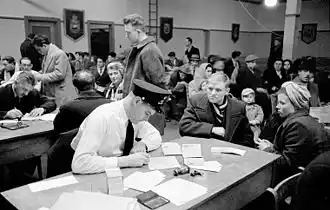
Canada's history is woven together by countless stories of migration, perseverance, and new beginnings. From early French settlers and United Empire Loyalists to waves of hopeful immigrants escaping famine, war, and economic hardship, Canada has long been a destination for those seeking opportunity and a better life. Among these many stories are the British Home Children, who were sent to Canada between 1869 and 1948, often with dreams of a better future but facing harsh realities.[1]
The records of these journeys—immigration documents, passenger lists, naturalization files—provide an invaluable glimpse into the lives of our ancestors. For genealogists, these records are often the key to uncovering the origins of our families, connecting names and dates with the larger stories of human resilience.
Understanding Canadian immigration records is not only about tracing our lineage but also about understanding the movements and struggles that shaped the nation as we know it today.
Research your ancestors on MyHeritage
Types of Canadian Immigration RecordsTypes of Canadian Immigration Records
Canadian immigration records come in many forms. These records document the paths they took, from their arrival by ship to their eventual naturalization as Canadian citizens.

- Passenger Lists - Before 1865, passenger documentation was inconsistent, and few records were kept by Canadian authorities. Ship captains were not required to maintain detailed lists, which means early records can be sparse or non-existent. From 1865 onward, Canadian authorities mandated ship captains to submit official passenger manifests. These lists typically include valuable information such as passenger names, ages, occupations, and final destinations. Depending on the time period, passenger lists may include details such as name, age, gender, nationality, occupation, destination, and the name of the ship. Later records often include more specific information such as, marital status and whether an individual had previously lived in Canada.
- Immigration Forms - Form 30A (1919-1924) During this period, the Canadian government introduced Form 30A as a replacement for traditional passenger lists. Instead of having a collective ship manifest, each passenger was required to fill out an individual form. This change was made to enhance the detail and accuracy of the information collected. Details Included on Form 30A typically contains name, age, marital status, occupation, nationality, last residence, destination in Canada, and details about the immigrant's family members or people they intended to join in Canada. It also included information on the person who paid for the passage and the person or organization who would be supporting them upon arrival. Because Form 30A captures more personal details, they can be extremely valuable for genealogists trying to understand the motivations and family context behind an ancestor's move. This form also provides clues about connections to family already in Canada, allowing researchers to follow familial links.
- Border crossing records [2] document the movement of individuals between Canada and the United States, and they are particularly useful for tracking ancestors who may not have traveled directly overseas but instead entered North America through a different country, either Canada or the United States. These records capture details about those who crossed the border at various official points and can provide vital clues about an ancestor’s movements, their origins, and even family connections.
There are other historical records that can provide valuable hints about our ancestors’ travels prior to arriving in Canada.
- Census Records: The 1901, 1911, 1921, and 1931 Canada Censuses have questions about immigration and naturalization dates. This can then provide a path to further research.
- Naturalization Records: A person born in another country may apply to become a Canadian citizen; this process is called naturalization. If you believe that your ancestor may have applied for naturalization you can search the citizen and naturalization databases at Library and Archives Canada. If your search is successful and you wish to purchase the file and you are a Canadian citizen, then you will be able to order that file. Note: that if your immigrate ancestor was a British subject then it was not necessary to apply for naturalization.
- Homestead applications and land grants. Homestead records can be a valuable source for tracing Canadian immigration. Often, they contain details about an individual’s origins, date of arrival in Canada, and movement and settlement patterns. Immigrants applying for homesteads often had to declare their intention to become British subjects (before Canadian citizenship was established in 1947). Homestead files sometimes include naturalization records or petitions showing an individual’s legal transition from an immigrant to a Canadian citizen. Land records can be found at Library and Archives Canada as well as in each individual province.
Chain migrationChain migration
Chain migration is a process where immigrants from a specific region or community, follow relatives, friends, or neighbors to a new country or settlement. This pattern creates clusters of people from the same origins in particular areas, helping new arrivals integrate more easily. It was a common phenomenon in Canadian immigration history, particularly among European settlers in the 19th and early 20th centuries.
Examples include:
- Ukrainians in the Prairie Provinces (Alberta, Saskatchewan, Manitoba)
- Mennonites in Manitoba and Saskatchewan
- Chinese communities in British Columbia
British Home ChildrenBritish Home Children

British Home Children (BHC) refers to the 100,000+ children sent from Britain to Canada between the 1860s and 1940s under child migration programs. It is estimated that 4 million Canadian’s are descendants of British Home Children[1]. Library and Archives Canada has a large database to help you search for your British Home Child ancestor. Additional help can be found at the Home Children Canada webpage.
Research your ancestors on MyHeritage
See alsoSee also
Explore more about immigration in CanadaExplore more about immigration in Canada
- History of the Province of Ontario (1872) record collection at MyHeritage
- 1901 Canada Census record collection at MyHeritage
- 1911 Canada Census record collection at MyHeritage
- 1921 Canada Census record collection at MyHeritage
- 1931 Canada Census record collection at MyHeritage
- Library and Archives Canada
- Home Children Canada

